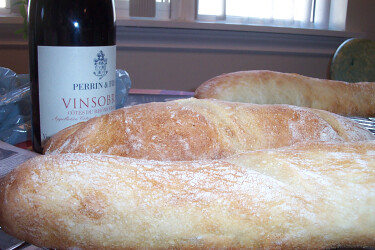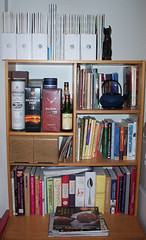
When I decided on my theme for this blog, bread was one of the first things that came to mind. While bread is considered an essential part of life in the Western world, it seems to be relatively unusual for people to make it at home. Despite the fact that it is a staple food, we don't make it from scratch, but rely instead on specialized producers to make it for us.
Indeed, bread has a reputation for being difficult to make, and it's a reputation that is not entirely undeserved, in my opinion. The last time I tried to bake bread, I was working from a recipe that called for all the ingredients by weight. Unfortunately, I was also working with a scale that was not nearly sensitive enough to weigh the ingredients in question, and the end result was inedibly salty. This time, on the recommendation of
The Foppish Baker, among others, I decided to invest in Peter Reinhart's
Bread Baker's Apprentice to gain a real understanding of the processes at work in breadmaking.
The book itself is beautiful, detailed and compellingly written. There were a few gaps in it, to my mind, but given their nature, I'm beginning to think they're gaps that could only be filled by a hands-on baking class. For example, the description of how to knead dough by hand is very cursory, and the instructions frequently say that the dough should be "tacky but not sticky," without giving any frame of reference for where the line between them is. On the other hand, I was pleased to learn that you can easily ferment dough at room temperature, and that it is impossible to overknead it by hand.
I entered this project knowing that it will likely take many attempts before I arrive at a loaf that satisfies me, so I decided to pick a type of bread that won't quickly bore me. To that end, I chose basic French Bread.
For my very first attempt, I wanted to focus on the basics, which meant not trying to shape the loaves into full-on baguettes just yet. Instead, I used the preliminary shape that is later formed into a baguette, called a
bâtard. Of this shape, Reinhart writes that it is "a viable and popular shape in its own right, delivering a nice balance of both crust and crumb." It's also short enough to fit on the pizza stone I would be using in lieu of a real baking deck.
The pâte fermentée went off without a hitch (it was rather like making my usual pizza crust) and went into the fridge to retard overnight. The next day, I mixed up the dough and kneaded for about ten minutes. When I tried the "windowpane test" by stretching out a small piece of dough, it ripped before becoming thin enough to see daylight through it, so I went back and kneaded a couple of minutes longer. This time, it seemed to work better, so I threw it in an oiled bowl, covered with plastic wrap, and left it for two hours.
Problem #1: How do you tell when dough has risen to twice its size? Well, I guessed. After 90 minutes, it looked like it was there, so I degassed it slightly and left it for anouther half hour. I probably should have used a straight-sided container marked with an elastic, like Alton Brown suggests, but I couldn't find one handy.
Problem #2: What happens if you haven't put a sufficient amount of oil into your bowl? Well, your dough sticks, and your attempts to unstick it will inevitably degas it pretty thoroughly.
At this stage, I was rather worried that I had degassed the dough too much for it to bake properly, but I pushed on nonetheless. I divided the dough (not too evenly, it turned out) shaped it, and put it in a makeshift couche made out of parchment. I'm still not convinced that I did this part correctly, and I may try using a cloth couche (read: tea towel) next time. I left it to proof until it was one-and-a-half times its size (there's that size thing again!), which I considered to have arrived by the 45-minute mark.
Problem #3: How the heck do you get dough off parchment and onto a peel without massively degassing it!? By the time I had transferred them, the beautifully shaped and risen loaves had become uneven and flat. At this point, I was doubly sure my first attempt was going to be a failure.
Problem #4: What happens if you don't put enough cornmeal on your makeshift aluminum peel? Well, you end up coaxing, cajoling and ultimately dropping your dough onto your too-samll pizza stone, thereby degassing it still further and causing the baker all sorts of worry about the end result.
In fact, the end result was surprisingly good, which I understand seems to mean that I got great "oven spring." One of the loaves was slightly overhanging the stone, which was on the lowest rack in my oven, and so it burnt slightly. Because I could smell it, but didn't realize what was going on, I ended up taking all three out before they were quite done, worried that the bottoms would burn to a crisp if left longer. So the crust was maybe a little lighter and softer than I would have wanted, and the crumb was just a shade too moist. The holes were a little small too, though I got a few nice big ones. Next time, I think I'll raise the oven rack one notch and leave the bread in a little longer.
And what was the fate of my first-ever loaf of French Bread? My husband and I adorned it with some great applewood-smoked cheddar cheese we picked up on our last run into Halifax.
The real victory of this attempt, though, was proving to myself that I can indeed make bread from scratch.


